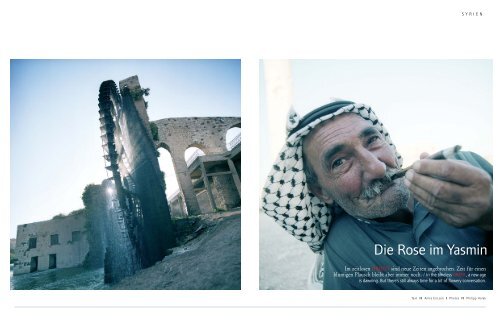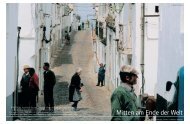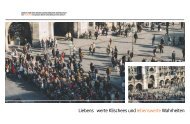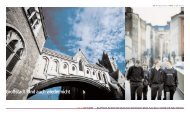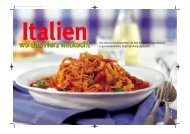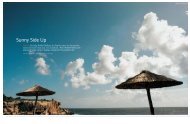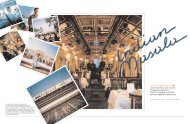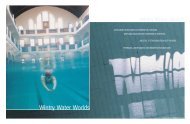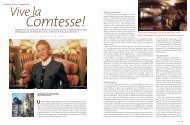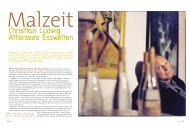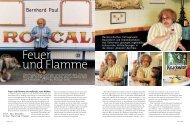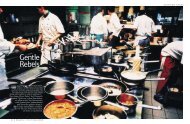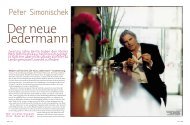Die Rose im Yasmin
Die Rose im Yasmin
Die Rose im Yasmin
Create successful ePaper yourself
Turn your PDF publications into a flip-book with our unique Google optimized e-Paper software.
SYRIEN<br />
<strong>Die</strong> <strong>Rose</strong> <strong>im</strong> <strong>Yasmin</strong><br />
Im zeitlosen ORIENT sind neue Zeiten angebrochen. Zeit für einen<br />
blumigen Plausch bleibt aber <strong>im</strong>mer noch. / In the t<strong>im</strong>eless ORIENT, a new age<br />
is dawning. But there’s still always t<strong>im</strong>e for a bit of flowery conversation.<br />
Text II Anita Ericson I Photos II Philipp Horak
Links: Im Souk von Aleppo trifft man sich gerne und vertreibt sich die Zeit mit Geschichtenerzählen. Rechts: Das nächtliche Damaskus wird <strong>im</strong> Hintergrund vom Berg Kassioun<br />
abgeschirmt. Dort, wo Kain einst Abel erschlagen haben soll, treffen sich heute die Damaszener zum nächtlichen Picknick. / Left: Aleppo’s souk is a great place to meet people and while<br />
away the hours listening to storytelling. Right: night-t<strong>im</strong>e Damascus with Mount Kassioun in the background. Damascene residents like to picnic where Cain is said to have killed Abel.<br />
SYRIEN
SYRIEN<br />
Links: <strong>Die</strong> Ruinen von Palmyra werden heute von einer Autostraße durchschnitten, die den Tempel von der alten Stadt trennt. Rechts: Das uralte Kloster von Mar Musa wurde von Bruder<br />
Paolo (2. v. r.) renoviert. Er hat sich dem „Dialog der Religionen“ verschrieben und bekommt Besuch aus aller Welt. / Left: a modern road now cuts through the ruins von Palmyra, separating the temple<br />
from the old city. Right: the ancient monastery of Deir Mar Musa was renovated by Brother Paolo (2 nd from r.). He has dedicated h<strong>im</strong>self to a dialogue among the religions and receives visitors from around the world.
Mitten <strong>im</strong> Nirgendwo zwischen Damaskus und Palmyra steht<br />
das „Café Bagdad“ mit angeschlossenem Hotel. <strong>Die</strong> beiden<br />
Söhne von Faraj, dem Besitzer, sind über die Abwechslung<br />
vorbeikommender Reisender hoch erfreut. / In the middle of<br />
nowhere between Damascus and Palmyra stands the Baghdad Café<br />
with its adjoining hotel. The two sons of Faraj the owner welcome the<br />
change of pace that travellers bring.<br />
In der Al Zaynabiyah Straße tobt der Verkehr. Auf drei<br />
Fahrspuren drängeln sich fünf Reihen von Autos. Hupen<br />
quäken ungeduldig. Bremsen quietschen, zwei Stoßstangen<br />
krachen. Rechts und links stehen hohe Häuser. „Als<br />
ich ein Kind war, haben wir hier Fußball gespielt“, erinnert<br />
sich Hassan Kharat, der gut genährte Fremdenführer, rund<br />
40 Jahre zurück. „Hier war die Stadt zu Ende. Auf der<br />
anderen Seite gab es nur noch Felder.“ Schwer vorzustellen,<br />
Damaskus ist mittlerweile von einer halben Million Einwohner<br />
auf geschätzte fünf Millionen angeschwollen.<br />
Auch Kamele, wie Hassan sie noch erlebt hat, sind längst<br />
aus dem Stadtbild verschwunden. Verblüffenderweise hat<br />
die Stadt ihren Zuwachs ohne Armutsviertel verkraftet,<br />
das Bild des verstorbenen Staatspräsidenten blickt auf<br />
saubere Straßen, ordentliche Häuser und sozialistischpompöse<br />
Kulturpaläste.<br />
Neuerdings auch auf unterkühlte Cafés, wo die Jeunesse<br />
dorée an ihrem Latte Macchiato nippt und auf<br />
verrauchte Musikpubs, in denen Jugendliche spärlich<br />
bekleidet zu schrägen Rhythmen shaken. <strong>Die</strong> 27-jährige<br />
Joumana repräsentiert die Damaszener Jugend von heute:<br />
„Es begann vor vier, fünf Jahren, plötzlich hat sich alles<br />
bewegt. Auf einmal gab es moderne Cafés und schicke<br />
Restaurants, NafNaf und Benetton.“ Hand in Hand mit<br />
der Öffnung Syriens nach außen ging die Öffnung nach<br />
SYRIEN<br />
innen, Joumana: „Es hängt natürlich von den Eltern ab,<br />
aber <strong>im</strong> Prinzip kann jeder heute so sein, wie er möchte.<br />
Ich habe Freundinnen, die haben von sich aus beschlossen,<br />
ein Kopftuch zu tragen. Andere kleiden sich nach der<br />
neuesten bauchfreien Mode.“ Sie gehen aus bis spät in die<br />
Nacht, fahren mit Freunden auf ein nächtliches Picknick<br />
und sie verabreden und verlieben sich. Joumana: „Das<br />
Leben in Damaskus ist schön.“<br />
Absolut angesagt ist momentan ein Besuch in der<br />
Nationaloper, die <strong>im</strong> April offiziell eröffnet wurde. Direktor<br />
Nabil Al-Lau: „Wir spielen Konzerte, Opern, Theaterstücke<br />
und Filme in einer Mischung aus arabisch und<br />
westlich, aus klassisch und modern. Wir sind mit der<br />
Hochschule für Theater und Musik verbunden und geben<br />
hier auch unseren Studenten die Möglichkeit, ans Publikum<br />
zu kommen.“ Direktor Al-Lau war selbst von der<br />
Resonanz überrumpelt: „Wir waren von Beginn weg ausverkauft.<br />
Bei manchen Aufführungen saßen die jungen<br />
Leute sogar auf den Treppen und am Boden.“<br />
Dem Besucher stechen freilich vor allem die Kontraste<br />
ins Auge, es ist das Moderne, das überrascht, aber das Alte,<br />
das begeistert. In der prachtvollen Omayadenmoschee glänzen<br />
Mosaike aus dem 8. Jahrhundert über Pilgerscharen<br />
aus dem Iran, während in der Maysaloun Straße Handtäschchen<br />
aus Frankreich die Schaufenster zieren. Jeden<br />
Abend sitzt der Märchenerzähler <strong>im</strong> „Café Al Nawfara“<br />
und bringt zum Blubbern der Wasserpfeifen ringsum seine<br />
Geschichten aus der Kreuzritterzeit zum Besten. Auf den<br />
Dächern der Stadt versinkt derweil ein Satellitenschüsselwald<br />
in der Nacht. Hippe Lokale sind in fünfhundert Jahre<br />
alte Innenhöfe eingezogen. In Textilfabriken am Stadtrand<br />
wird für internationale Konzerne industriell produziert,<br />
während in kleinen Werkstätten in der Altstadt Ware in<br />
uralter Tradition von Hand gefertigt wird.<br />
43
Im kleinen Handwerksmarkt <strong>im</strong> Schatten der osmanischen<br />
Tekkiye Sula<strong>im</strong>an Moschee kann man diese Sachen<br />
nicht nur kaufen, sondern auch bei der Herstellung<br />
zusehen. Hier sitzt Ahmed an seinem mit Lochkarten<br />
programmierten Webstuhl und schiebt Schiffchen mit<br />
Seidenfäden ohne Eile hin und her. Im Shop ums Eck<br />
schmiedet der Armenier Hagop Silber zu außergewöhnlichen<br />
Schmuckstücken zusammen. Sein Vater sitzt vor<br />
dem Laden und trinkt ein Tässchen Kaffee, er selbst hat<br />
noch mit Gold gearbeitet. Ein paar Läden weiter beugt sich<br />
Yahya über ein kleines Holzkästchen und setzt mit engelsgleicher<br />
Geduld winzige Holz- und Perlmuttplättchen zu<br />
einem Intarsienkunstwerk zusammen. Wie lange er für so<br />
eine Arbeit braucht? „So eine Frage kann nur ein Europäer<br />
stellen. Wenn es fertig ist, ist es fertig.“<br />
Damaskus ist möglicherweise die älteste durchgehend<br />
bewohnte Stadt der Welt. In Damaskus wurde der ungläubige<br />
Saulus zum Apostel Paulus, der das Christentum<br />
weiter in die Welt trug. Hier war es angeblich auch, wo<br />
Kain seinen Bruder Abel erschlug. Das soll sich am<br />
Kassioun Berg zugetragen haben, auf dem heute Familien,<br />
Freunde und Pärchen in aller Friedlichkeit das nächtliche<br />
Lichtermeer über den Dächern und Minaretten der<br />
Stadt genießen.<br />
Ganz Syrien ist uralter Kulturboden, besiedelt seit der<br />
Altsteinzeit. Erste Hochkulturen entstanden schon früh,<br />
auf ihren Fundamenten haben Griechen und Römer,<br />
Byzantiner und arabische Kalifen ihre Heiligtümer und<br />
Festungen errichtet. Kreuzritter kamen und gingen, Türken<br />
kamen und blieben vierhundert Jahre. Alle haben sie ihre<br />
Spuren hinterlassen. Entlang der Hauptroute Damaskus–<br />
Aleppo finden sich beispielsweise christliche Klöster,<br />
Kreuzritterburgen oder mittelalterliche Wasserräder. Am<br />
Euphrat liegen in Mari die letzten Reste einer der ältesten<br />
Stadtsiedlungen überhaupt und in der Wüste stehen gigantische<br />
Schlösser wie Trugbilder <strong>im</strong> Nichts.<br />
Das schönste Stück Geschichte liegt ebenfalls tief in<br />
der Wüste: die antike Tempelstadt Palmyra. <strong>Die</strong> Fahrt geht<br />
durch eine staubtrockene Steinwüste, die mehr durch Hitze<br />
und Weite beeindruckt als durch Schönheit. Ein kurzer<br />
Stopp <strong>im</strong> „Café Bagdad“, mitten <strong>im</strong> Nirgendwo, wo Beduine<br />
Faraj vor neun Jahren die erste Wüstenraststation eröffnet<br />
hat. In seinem kleinen Laden gibt es Muscheln und Korallenstöcke<br />
zu kaufen, die seine beiden Söhne bei ihren<br />
Streifzügen durch die monochrome Landschaft, die offensichtlich<br />
einmal ein Meer war, gefunden haben. <strong>Die</strong><br />
schnurgerade Straße führt weiter und kurz bevor man die<br />
Hoffnung aufgibt, bringt die Oase von Palmyra endlich<br />
wieder Farbe ins Bild. Hinter einem Hain aus Palmen,<br />
Granatapfel- und Olivenbäumen ragen die Säulen und<br />
Grabtürme der einst blühenden Karawanenstation am Weg<br />
SYRIEN<br />
von Fernost nach Rom in den dunstigen H<strong>im</strong>mel. Das<br />
Wüstenkl<strong>im</strong>a hat Tempel und Theater, Stadttore und die<br />
Kolonnadenstraße bestens konserviert. Das heutige Palmyra<br />
liegt gleich daneben, das schönste Panorama ergibt<br />
sich zur abendlichen Dämmerstunde am Qala’at Ibn Ma’n,<br />
dem Zitadellenhügel. Sehr nett auch der Tagesausklang<br />
<strong>im</strong> Gastgarten des Hotels Zenobia, erste Reihe fußfrei zu<br />
den beleuchteten Ruinen.<br />
Auch Aleppo, die zweitgrößte Stadt Syriens, verdankt<br />
ihre Existenz dem jahrhundertelangen Handel zwischen<br />
Ost und West. In der Karawanserei Al-Wesir sitzt ein grau<br />
melierter Herr und schmaucht eine Wasserpfeife. Seine<br />
Seidenkrawatte ist dezent gemustert, die geflochtenen<br />
Lederschuhe zur tadellos gebügelten Hose unterstreichen<br />
die vornehme Erscheinung. Er sitzt vor einem unscheinbaren<br />
Büro, die Blüten zwischen den Büschen rechts und<br />
links duften zart. „Ahh, hier sitzt die <strong>Rose</strong> zwischen dem<br />
<strong>Yasmin</strong>“, eröffnet Hassan das Gespräch in orientalischer<br />
Blumigkeit. Mit der <strong>Rose</strong> ist der distinguierte Herr gemeint<br />
und tatsächlich zaubern ihm die Worte ein Lächeln auf die<br />
Lippen. Schon ist das Gespräch <strong>im</strong> Gang. Abdel Hamid<br />
Chehade ist ein reicher Aleppiner Händler und Fabrikant:<br />
„Mein Sohn und ich, wir führen die Familientradition fort.<br />
Seit mindestens 340 Jahren sind wir <strong>im</strong> Geschäft.“ Seine<br />
ganze Erscheinung zeigt, dass es sich auch heute vortrefflich<br />
davon leben lässt. „Wir verkaufen Stoffe aus<br />
eigener Erzeugung nach Europa. Vieles geht nach Frankreich,<br />
wir produzieren aber auch für Armani in Italien oder<br />
Aigner in Deutschland“, sagt Abdel Hamid und bedeutet<br />
seinem Gehilfen, ein paar Muster zu bringen. „Auch unsere<br />
Seife – echte Aleppiner Olivenseife, hergestellt nach unserem<br />
Spezialrezept – exportieren wir nach Europa. Jeden<br />
Monat verschicken wir zwei bis drei Container mit dem<br />
Schiff.“ Ansonsten handelt er mit Waren aller Art, so sind<br />
derzeit etwa hundert Tonnen Kümmel in seinem Auftrag<br />
am Landweg in den Yemen unterwegs.<br />
Abdel Hamids Familie ist feinste Aleppiner Oberschicht.<br />
Sie ist keine Ausnahme in einer Stadt, die durch Handel<br />
groß geworden und ihm bis heute treu geblieben ist. <strong>Die</strong><br />
Waren der Großhändler stapeln sich vornehmlich in den<br />
unzähligen Karawansereien, die <strong>im</strong> Gassenlabyrinth des<br />
Souks stecken. Vor ihren Höfen läuft en detail in winzigen<br />
Linke Seite v. o. n. u.: Ahmed der Weber vor seinen wunderbaren Seidenstoffen,<br />
Restaurant in einem alten Innenhof in Damaskus und die junge Joumana mit Freundin:<br />
„Das Leben in Damaskus ist schön.“ Rechte Seite v. o. n. u.: der renovierte Souk<br />
al-Hamidiye in Damaskus, der Aleppiner Händler und Fabrikant Abdel Hamid und der<br />
armenische Silberschmied Hagop mit seinem Vater in Damaskus. / Left page from top to<br />
bottom: Ahmed the weaver with his wonderful silks, a restaurant in an old Damascus courtyard, and<br />
young Joumana with a friend: “Life in Damascus is lovely.” Right page from top to bottom: the<br />
renovated Hamidiye souk in Damascus, the merchant and manufacturer Abdel Hamid<br />
in Aleppo, and the Armenian silversmith Hagop with his father in Damascus.<br />
44 45
Lebensader Euphrat. Seit vorchristlicher Zeit dient der Fluss zum Bewässern der Felder. <strong>Die</strong> Ufer des Stausees sind heute ein beliebtes Erholungsgebiet. /<br />
The Euphrates, the river of life: since pre-Christian t<strong>im</strong>es the river has been used for irrigation. Today the banks are a popular recreation area.<br />
Shops die ganze Vielfalt Arabiens über die Ladentische.<br />
Honigtriefende Süßigkeiten stapeln sich zu Pyramiden.<br />
Laufburschen balancieren Tabletts mit nach Kardamom<br />
duftendem Kaffee durchs Gewühl. Frauen, bis zu den<br />
Fingerspitzen verhüllt, lassen sich seidige Stoffe vom<br />
Ballen rollen. Moscheen, Hammams und Stadthäuser<br />
reicher Bürger umgeben den überdachten Souk, hinter<br />
den Fassaden oft eine ungeahnte Fülle: Fußböden<br />
aus Marmorteilen zu bunten Mustern verlegt. Holzvertäfelte<br />
Wände, ornamentale Steinmetzarbeiten, allgegenwärtige<br />
Brunnen. Über all dem wacht eine<br />
mächtige Zitadelle.<br />
In Aleppo findet man einen Orient, den man so nur<br />
aus Märchen oder von alten Kupferstichen kennt. Man<br />
schaut be<strong>im</strong> Juwelier vorbei und hält sogleich eine Tasse<br />
Tee in den Händen. Ein Geplauder entspinnt sich. „Frauen<br />
aus Europa lieben arabischen Stil, unsere Frauen<br />
schätzen westliches Design“, weiß Schmuckhändler<br />
Osama zu berichten. Auf die plausible Erklärung dafür<br />
– man will halt <strong>im</strong>mer das, was man nicht hat – hält<br />
Osama in morgenländischer Manier eine Geschichte<br />
parat: „Es war einmal ein reicher, verheirateter Mann,<br />
der verliebte sich in eine andere. <strong>Die</strong> war klug und gab<br />
ihm einen Teller bunter Eier zu essen. Der Mann aß<br />
zuerst das rote, dann das grüne, dann das blaue. Er<br />
musste feststellen, dass alle gleich schmecken. ,Siehst<br />
du‘, sagte die Frau, ,so ist das mit uns Frauen auch, nach<br />
innen sind wir nicht so verschieden wie nach außen.‘“<br />
Tausendundeine Nacht wird in Aleppo täglich tausendfach<br />
aufs Neue erzählt.<br />
THE ROSE AMONG THE JASMINE Traffic is roaring down<br />
Al Zaynabiyah Street, with five rows of cars competing for three<br />
lanes. Impatient honking, screeching brakes, the sound of<br />
bumpers colliding. Tall buildings on the left and right. “When<br />
I was a child, we used to play football here”, remembers Hassan<br />
Kharat, our well-nourished tourist guide, thinking back some<br />
40 years. “This was the edge of the city. On the far side there<br />
was nothing but fields.” Hard to <strong>im</strong>agine, given the fact that<br />
Damascus has meanwhile grown from half a million residents<br />
to an est<strong>im</strong>ated five million. The camels that Hassan can still<br />
remember seeing on the city streets have long since disappeared.<br />
Astonishingly, the city has managed its gigantic growth<br />
without building slums. Pictures of the late president, Hafez<br />
al-Assad, look down on clean streets, well-maintained buildings<br />
and cultural palaces in socialist-ostentatious style.<br />
And more recently, also on cool cafés, where Syria’s jeunesse<br />
dorée sits sipping their latte macchiato, and on smoky music<br />
clubs where scantily clad youths are shaking to hot rhythms.<br />
Joumana, 27, represents the Damascene youth of today: “It all<br />
46 47<br />
SYRIEN<br />
SYRIEN<br />
HOTELS: Cham Palaces & Hotels, Tel.: 00963/11/223 23 00,<br />
www.chamhotels.com. <strong>Die</strong> einzige syrische Luxushotelkette besitzt<br />
zwölf Häuser <strong>im</strong> ganzen Land, darunter zwei Hotels und einen Golf- &<br />
Countryclub in Damaskus, ein Hotel in Palmyra und eines in Aleppo.<br />
Beit Wakil, Sissi Street, Al Jdaidah, Aleppo, Tel.: 00963/21/221 71 69,<br />
www.beitwakil.com. Das erste alte Stadthaus in Aleppo, das man zu<br />
einem kleinen, feinen Hotel umgebaut hat. Das Haus wurde von<br />
seinen Besitzern behutsam und vorbildlich renoviert. Im Restaurant<br />
überlieferte Aleppiner Küche.<br />
Zenobia Hotel, Ruins Center, Palmyra, Tel.: 00963/31/91 29 07,<br />
zenobia-hotel@net.sy. Liegt direkt neben den Ruinen, die Z<strong>im</strong>mer<br />
sind mit altbackenem Charme eingerichtet. Nicht ganz so luxuriös wie<br />
andere, aber sehr sympathisch. Wenn Sie nicht hier wohnen: unbedingt<br />
zumindest den Gastgarten besuchen!<br />
RESTAURANTS: Casablanca Restaurant, Hanania Street, Bab Sharki,<br />
Damaskus. Gehobenes Lokal <strong>im</strong> Ambiente eines alten Patrizierhauses.<br />
Am Menü findet sich eine Mischung aus arabischer und internationaler<br />
Küche, zum Teil zu ungewöhnlichen Zusammenstellungen komponiert.<br />
Jabri House, Alsawaf Street, Damaskus. Wie so viele andere, die in<br />
jüngster Zeit aus dem Boden geschossen sind, in einem alten Innenhof<br />
untergebracht. Junges Publikum, es geht hier sehr locker und<br />
ungezwungen zu.<br />
Dar Zamaria, Al Jdaidah, Aleppo. Ein weiteres Restaurant in einem<br />
alten, restaurierten Stadthaus. Man kann <strong>im</strong> Innenhof sitzen oder<br />
auf der rundum laufenden Terrasse mit Blick über die Dächer des<br />
renovierten Armenierviertels. Auch ein sehr nettes Hotel.<br />
LEUTE TREFFEN: Café Al Nawfara, Damaskus. Legendäres Café direkt<br />
hinter der Omayadenmoschee. Hier fabuliert noch jeden Abend der<br />
Märchenerzähler.<br />
Marmar, Bab al Touma, Damaskus. Verrauchtes Musikpub, das von<br />
der Jugend begeistert gestürmt wird. Nach Mitternacht wird auf der<br />
kleinen Tanzfläche abgetanzt.<br />
The Baron Hotel, Aleppo. Einst stieg hier alles ab, was Rang und<br />
Namen hatte – von Lawrence von Arabien bis Kemal Atatürk. Lange<br />
Zeit verfiel das Haus, derzeit werden die Z<strong>im</strong>mer adaptiert. Auf jeden<br />
Fall lohnt der Besuch der nostalgischen Bar. Auch schöne Terrasse.<br />
NICHT VERSÄUMEN: Hammam Yalbougha Al Nasery, Aleppo. Eines<br />
der schönsten Hammams in Syrien, wenn nicht das schönste, ist dieses<br />
Bad aus dem 14. Jahrhundert. Unbedingt empfehlenswert zur Badezeit<br />
(getrennte Männer- und Frauenzeiten): Lassen Sie sich eindampfen,<br />
waschen und massieren.
SYRIEN<br />
HOTELS: Cham Palaces & Hotels, tel.: 00963/11/223 23 00,<br />
www.chamhotels.com. The only Syrian luxury hotel chain has<br />
12 establishments, including two hotels and the Cham Golf & Country Club<br />
in Damascus, a hotel in Palmyra and one in Aleppo.<br />
Beit Wakil, Sissi Street, Al Jdaidah, Aleppo, tel.: 00963/21/221 71 69,<br />
www.beitwakil.com. The first old townhouse in Aleppo to be converted into<br />
a fine hotel. The building has been restored by its owners in an exemplary<br />
manner. The restaurant features traditional Aleppo cuisine.<br />
Zenobia Hotel, Ruins Center, Palmyra, tel.: 00963/31/91 29 07,<br />
zenobia-hotel@net.sy. The rooms overlook the ruins and have been decorated<br />
with old-fashioned charm. Not as luxurious as other choices but very<br />
attractive. Even if you don’t stay here, be sure to visit the garden.<br />
RESTAURANTS: Casablanca Restaurant, Hanania Street, Bab Sharki,<br />
Damascus. Fine restaurant with the ambience of an old patrician house.<br />
The menu offers a mixture of Arab and international cuisine,<br />
somet<strong>im</strong>es in unusual combinations.<br />
Jabri House, Alsawaf Street, Damascus. Like so many other restaurants<br />
that have been springing up like mushrooms, located in an old courtyard.<br />
Young clientele in a very relaxed atmosphere.<br />
Dar Zamaria, Al Jdaidah, Aleppo. Another restaurant in an old, restored<br />
townhouse. One can dine in the courtyard or on the sweeping terrace<br />
with its view across the rooftops of the renovated Armenian quarter.<br />
Also a very nice hotel.<br />
RENDEZVOUS: Café Al Nawfara, Damascus. Legendary café right behind<br />
the Umayyad Mosque. Every evening the storyteller tells his tales.<br />
Marmar, Bab al Touma, Damascus. Smoky bar-disco that is extremely popular<br />
with young people. Dancing after midnight.<br />
The Baron Hotel, Aleppo. Everyone who was anyone used to stay here:<br />
from Lawrence of Arabia to Kemal Atatürk. The hotel declined for many<br />
years but the rooms are currently being renovated. The bar is well worth<br />
a nostalgic visit. Lovely terrace, too.<br />
NOT TO MISS: Hammam Yalbougha Al Nasery, Aleppo. This 14th-century bath is one of the loveliest hammams in Syria – perhaps the very loveliest.<br />
Be sure to visit the hammam (separate opening t<strong>im</strong>es for men and women)<br />
and let yourself be steamed, washed and massaged. SYRIA<br />
48<br />
Auf einen Blick: <strong>Die</strong> Ausgrabungen von Palmyra gibt’s<br />
natürlich auch <strong>im</strong> Postkartenformat. / The ruins at a glance:<br />
the excavations of Palmyra are also available in postcard format.<br />
started about four or five years ago, when everything suddenly got<br />
moving. All at once, there were modern cafés and chic restaurants,<br />
Nafnaf and Benetton.” Hand in hand with the opening of Syria to<br />
the outside world, an internal opening occurred as well. Joumana<br />
says, “Of course it depends on your parents, but as a rule everybody<br />
can be what they want to be today. I have girlfriends who<br />
decided on their own to wear a headscarf. Others like to wear the<br />
latest fashions with bare midriffs.” They stay out late at night, driving<br />
off with friends for an evening picnic, for example. And they meet<br />
and fall in love. According to Joumana, “Life in Damascus is lovely.”<br />
A real must at the moment is the National Opera, which officially<br />
opened in April. Its director, Nabil Al-Lau, describes the<br />
programme: “We offer concerts, operas, dramas and films in a<br />
mixture of Arab and Western, classic and modern styles. We are<br />
closely connected with the School of Music and Performing Arts<br />
and offer students a chance to perform publicly.” Al-Lau was<br />
surprised at the incredibly positive reaction: “We’ve been sold out<br />
from day one. For some performances, we’ve had young people<br />
sitting on the stairs or on the floor.”<br />
Visitors may notice the contrasts more than anything else:<br />
Damascus is surprisingly modern on the one hand and excitingly<br />
ancient on the other. In the magnificent Umayyad Mosque,<br />
8 th -century mosaics glisten above the heads of Iranian pilgr<strong>im</strong>s,<br />
while the shop windows on Maysaloun Street display French handbags.<br />
Every evening a storyteller sits in Café Al Nawfara, telling<br />
tales from the Crusader period while the water-pipes bubble around<br />
h<strong>im</strong>. Meanwhile, on the rooftops of the city a forest of satellite<br />
dishes is fading into the night. Hip restaurants have moved into<br />
500-year-old courtyards. The textile factories on the edge of<br />
the city are now producing goods for international firms, while the<br />
small workshops in the old part of town are still making traditional<br />
wares by hand.<br />
At the small craftsmen’s market in the shadow of the Ottoman<br />
Tekkiye Mosque, one can not only buy these things but also watch<br />
as they’re being made. Here Ahmed sits at his loom, programmed<br />
by punched cards, and unhurriedly slides the shuttle with the silk<br />
thread back and forth. At the shop around the corner, Hagop the<br />
Armenian is fashioning unusual silver jewellery. His father sits in<br />
front of the shop, sipping a tiny cup of coffee and remembering<br />
the days when he used to work in gold. A couple of shops further<br />
along, Yahya is bent over a small wooden box, patiently inlaying it<br />
with tiny pieces of wood and mother-of-pearl to create a real<br />
artwork. How long it takes to make something like this? “That’s a<br />
question only a European would ask. It’s finished when it’s finished.”<br />
Damascus is possibly the oldest continuously inhabited city<br />
in the world. On the road to Damascus the unbelieving Saul<br />
became the Apostle Paul, spreading Christianity into the wider<br />
world. This is where they believe Cain murdered his brother,<br />
Abel. The incident is supposed to have taken place on Mount<br />
Kassioun, where today families, friends and young couples go<br />
at night to peacefully enjoy the sea of lights across the rooftops<br />
and minarets of the city.<br />
All of Syria is part of an ancient cultural area that has been<br />
settled since the Old Stone Age. The first advanced civilisations<br />
were here at an early date, and their architectural remains<br />
were used by the Greeks and Romans, Byzantine princes and<br />
Arab caliphs as the foundations for their own temples and fortresses.<br />
The Crusaders came and went; the Turks came and stayed<br />
for the next 400 years. All of them left traces behind. Along<br />
the main road from Damascus to Aleppo, for example, there<br />
are still Christian monasteries, Crusaders’ castles and medieval<br />
water-wheels. At Mari on the Euphrates River lie the remains<br />
of one of the oldest cities in the world, and gigantic miragelike<br />
castles are dotted across the desert.<br />
The loveliest historical site also lies deep in the desert: the<br />
ancient temple city of Palmyra. The approach leads through a<br />
parched stony desert, more <strong>im</strong>pressive for its heat and expanse<br />
than for its beauty. We make a short stop at the Baghdad Café<br />
in the middle of nowhere. Here Bedouin Faraj opened the first<br />
desert rest stop nine years ago. His small shop sells shells and<br />
pieces of coral that his two sons have collected during their<br />
expeditions across the monochromatic landscape, which must<br />
once have been a sea. The dead-straight road leads on, and just<br />
before abandoning all hope, one arrives at Palmyra, an oasis<br />
that brings colour back to the landscape. Behind a grove of<br />
palms, pomegranate and olive-trees, the columns and tombs of<br />
the once-flourishing caravan station on the way from the Far<br />
East to Rome rise into the hazy sky. The desert cl<strong>im</strong>ate has done<br />
a wonderful job of preserving temples and theatres, city gates<br />
and <strong>im</strong>pressive colonnades. Modern Palmyra lies right beside<br />
the ancient ruins. The loveliest evening panorama can be had<br />
by cl<strong>im</strong>bing up to the castle on the hill, Qalaat ibn Maan. A great<br />
way to end the day is to sit at the edge of the garden at Hotel<br />
Zenobia, with its view of the illuminated ruins.<br />
Aleppo, the second-largest city in Syria, also owes its<br />
existence to centuries of East-West trade. At the Al-Wesir caravanserai<br />
sits a greying gentleman, drawing on a water-pipe. His<br />
silk tie is discreetly patterned, and his woven leather shoes and<br />
perfectly ironed trousers underline the elegance of his appearance.<br />
He is sitting in front of a nondescript office, and sweetly<br />
scented flowers are in bloom on the bushes to his left and<br />
right. “Ah, the rose is sitting among the jasmine”, says Hassan,<br />
opening conversation with the gentleman in flowery oriental<br />
style. With “rose” he means the distinguished gentleman h<strong>im</strong>self<br />
and, indeed, the words bring a smile to the latter’s lips.
SYRIEN<br />
Graphik: Mario Gegenhuber<br />
50<br />
<strong>Die</strong> Lichter von Damaskus: Nächtliches Familientreffen<br />
am Berg Kassioun. / The lights of Damascus: night-t<strong>im</strong>e family<br />
rendezvous on Mount Kassioun.<br />
CY<br />
IL<br />
LB<br />
JO<br />
TR<br />
SY<br />
IQ<br />
ALEPPO<br />
DAMASKUS<br />
PALMYRA<br />
E U P H R A T<br />
SYRIEN<br />
Austrian fliegt täglich von Wien nach Damaskus und zwe<strong>im</strong>al pro Woche nach Aleppo. /<br />
Austrian flies daily from Vienna to Damascus and twice a week to Aleppo.<br />
A conversation ensues. The gentleman, Abdel Hamid<br />
Chehade, is a wealthy merchant and manufacturer in Aleppo:<br />
“My son and I are continuing the family tradition. We have<br />
been in business for at least 340 years.” And his appearance<br />
is test<strong>im</strong>ony to the fact that the business is still doing<br />
extremely well. “We produce fabrics and sell them to Europe.<br />
Lots of it goes to France, but we also produce for Armani in<br />
Italy, for example, and for Aigner in Germany”, says Abdel<br />
Hamid, signalling to his employees to bring out some<br />
samples. “We also export our soap to Europe: genuine Aleppo<br />
olive soap, produced according to our own special recipe.<br />
Every month we dispatch two or three containers by ship.”<br />
Otherwise he deals in goods of every kind. At the moment,<br />
for example, about a hundred tonnes of caraway is on its<br />
way to Yemen by land.<br />
Abdel Hamid’s family is a member of Aleppo’s finest upper<br />
class. And it is not exceptional in a city that has flourished<br />
through trade and remained true to that tradition. The wares<br />
of the wholesalers are piled high in the countless caravanserais<br />
that are hidden away in the labyrinth of the souk,<br />
where tiny retail shops offer the whole range of Arabian products.<br />
Sweets dripping with honey are piled in high pyramids.<br />
Errand boys balancing trays laden with cardamom-scented<br />
coffee make their way through the crowds. Women veiled<br />
from head to toe buy silky fabrics from bales of material.<br />
Mosques, baths and the townhouses of wealthy citizens<br />
surround the roofed-over souk. And there is often an unsuspected<br />
richness behind the façades as well: inlaid marble<br />
floors in colourful patterns, wood-panelled walls, ornamental<br />
stone masonry and fountains everywhere. Above it all,<br />
the mighty citadel keeps watch.<br />
Aleppo offers a kind of orient that is otherwise known<br />
only from ancient fairy-tales or old copperplate engravings.<br />
No sooner have you entered a jeweller’s shop than you find<br />
a cup of tea in your hands and a conversation enfolds.<br />
“European women love Arabian style, while our women<br />
like Western design”, says jeweller Osama. The entirely<br />
plausible explanation: we always want what we don’t have,<br />
and Osama tells an oriental story to make his point: “There<br />
was once a rich married man who fell in love with another<br />
woman. She was wise and gave h<strong>im</strong> a plate of coloured eggs<br />
to eat. The man first ate the red ones, then the green and<br />
then the blue. And he had to admit that they all tasted alike.<br />
‘You see’, said the woman, ‘it’s the same with us women:<br />
we’re not as different on the inside as we are on the outside.’”<br />
The Thousand and One Nights are retold a thousand<br />
t<strong>im</strong>es a day in Aleppo.


